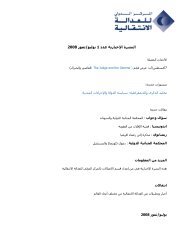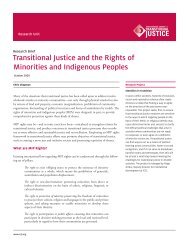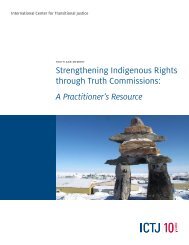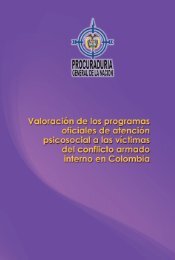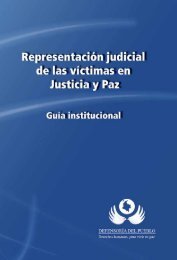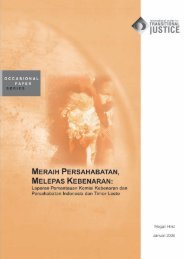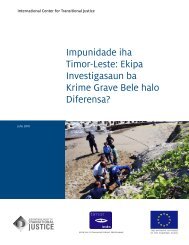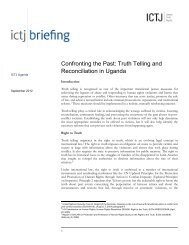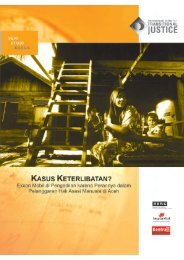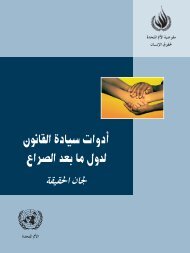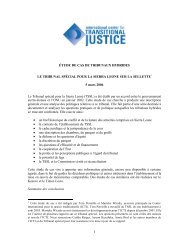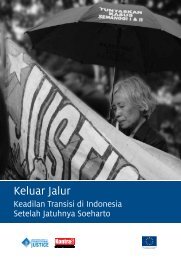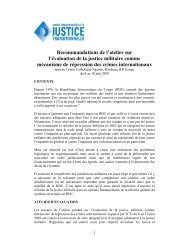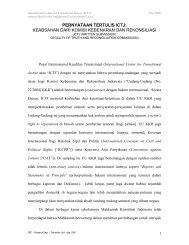That Someone Guilty Be Punished - International Center for ...
That Someone Guilty Be Punished - International Center for ...
That Someone Guilty Be Punished - International Center for ...
Create successful ePaper yourself
Turn your PDF publications into a flip-book with our unique Google optimized e-Paper software.
there was such a silence ... that you can hear. It’s a horrible silence. And it lasted <strong>for</strong> [a]<br />
long [time]…. And <strong>for</strong> me it was the most important moment of the day. Then we had<br />
a lunch break, and you could see the change. Now the people …are leaving the room,<br />
looking down, some were commenting, “You know, we really didn’t know this, it is a<br />
horrible crime.”<br />
Todorović thought that many would not return after the lunch break but they did, and<br />
everyone stayed until the end of the program. Todorović said, “I really think that they left a<br />
bit different.” 676 Describing this same program, Nerma Jelačić said, “people were genuinely<br />
shocked.” 677<br />
Todorović shared another perception of the dynamics at play during programs like<br />
the one described above. In his view, many of the “ordinary people” who were not involved<br />
in committing war crimes had a chance “to make a distance” from those who did. Todorović<br />
recognized that the premise of their reaction—that participants believe that what they heard<br />
in the ICTY program “has nothing to do with me”—may itself seem to be a <strong>for</strong>m of denial.<br />
But he noted that, if you insist that all Serbs are guilty, “you don’t give them a chance to<br />
change. And if you push a man to the wall, what can he do but say ‘yes, yes, I am the same,<br />
so what?’” 678 <strong>Be</strong>yond their potential impact in advancing acknowledgment of crimes and condemning<br />
them, these programs, Todorović believes, can help people understand that people<br />
from their communities “weren’t convicted because they were Bosniak, Serb, or Croat but<br />
because they committed crimes.” 679<br />
While the programs described above suggest the potential impact of effective outreach<br />
ef<strong>for</strong>ts, it would be misleading to suggest that an occasional conference can fundamentally<br />
change deeply entrenched attitudes. Describing the seemingly trans<strong>for</strong>mative Bridging the<br />
Gap programs, Jelačić said, “You can genuinely plant that seed, and then you need to go back<br />
and water it.” 680 This is not to say the follow up work has to be done by the ICTY, but it has<br />
to be done.<br />
Refik Hodžić, who played a central role in designing the Bridging the Gap project, was<br />
(once again) the Tribunal’s liaison officer in Sarajevo at the time of our July 2009 interviews.<br />
When we spoke with Hodžić then, he expressed concern about the project’s long-term impact.<br />
The day be<strong>for</strong>e we spoke, a nationalist group had disrupted the annual commemoration of<br />
the Srebrenica massacre, “chanting insults” against the Muslim survivors. 681 Like many with<br />
whom we spoke, this came as yet another alarming marker of Bosnia’s increasingly heated<br />
political climate. And in this setting, it was hard to be optimistic about the ICTY’s ability to<br />
foster change. With limited resources—the ICTY has only one outreach officer in all of Bosnia—the<br />
ICTY is vastly outmatched when it comes to creating a compelling narrative. People<br />
living in the communities where Bridging the Gap programs have been convened “are exposed<br />
to other rhetoric” on a daily basis. 682<br />
104 TRUTH AND ACKNOWLEDGMENT



